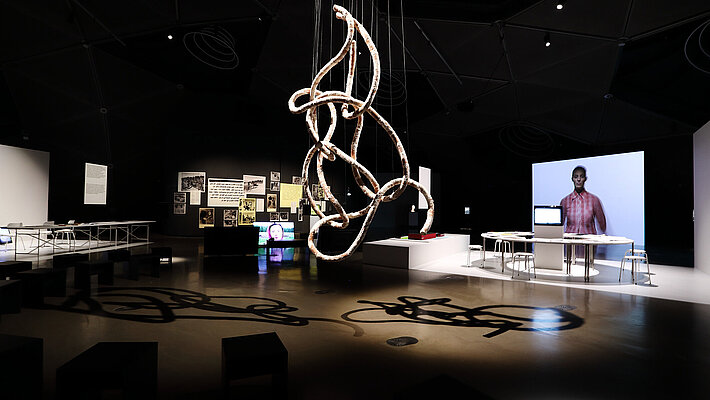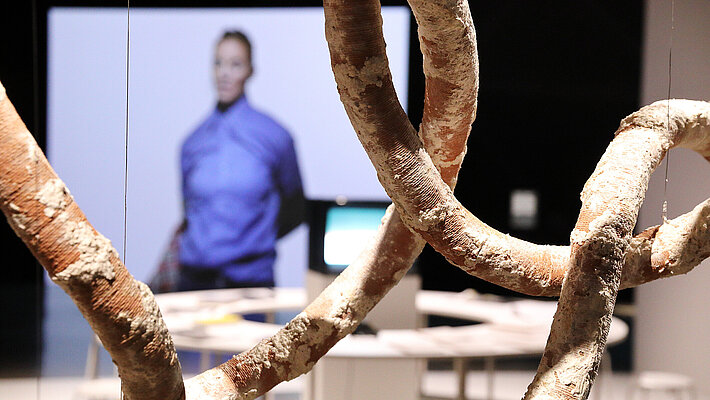|
|
|
|
|
|
Graz, 30 June 2025
Milica Tomić’s solo exhibition On Love Afterwards opens up a multi-layered space where questions of memory, political violence and personal responsibility take centre stage. Bridging artistic research and collective practice, she examines historical and contemporary realities – countering violence with a radically different concept: love. The exhibition offers comprehensive insight into Tomić’s practice spanning over 30 years, merging artistic, theoretical and socio-political elements.
|
|

The exhibition "On Love Afterwards" shows works by the artist Milica Tomić from the past 30 years, photo: Kunsthaus Graz/J.J. Kucek
|
|
|
|
|
|
|
|
|
|
|
|
The exhibition’s title deliberately introduces the concept of love. At first glance, this hardly aligns with works that speak of political resistance, political crime, genocide and exploitation. Love in this context comes as an antipode, as part of an attempt to find another language, another way of thinking about those difficult topics, about historical and recent events that characterise the present moment. One of the first works we encounter in the exhibition is a video work, which also gave the exhibition its name and is a quote by the poet Radovan Zogović. While the protagonists of the video On Love Afterwards tell us about their experience and motivation for joining the resistance and anti-fascist movement during World War II, their statements reveal personal responsibility, courage, love and faith in a better tomorrow.
The exhibition presents Milica Tomić’s practice that spans over 30 years in its entirety. Included here is a selection of works expanded and complemented by archival material. The fluid and loosely defined boundary between artistic work and research is reflected in the very concept of the exhibition architecture, providing background and insight into her individual and collective practice.
One of the central works in the exhibition is a multi-layered piece titled The Portrait of My Mother. Milica Tomić films a walk through the city in the walk of the bombing of Serbia and Kosovo in 1999. While tracing a path that reveals layers of the city, the viewer gains insight into the artist’s complex relationship with her mother. In this, a dialogue is established between the artist, the urban landscape and an intimate history deeply intertwined with the political. The installation centres around an absent object, represented by an image of a large-scale tapestry made by the artist’s mother. The sculptural tapestry no longer exists, having been discarded by the artist herself. Only a slide remains. The piece consisted of knots and weaving – a technique frequently used by female artists in the former Yugoslavia. For Tomić, the knot in itself carries layered meanings; beyond its material form, it evokes the Borromean knot – a psychoanalytic model that articulates the way in which the Real, the Symbolic and the Imaginary are interwoven. In this context, the knot becomes the product of subjectivation, binding individual identity to collective memory, trauma, and the political unconscious.
|
|

The artist's first major solo exhibition can be seen at Kunsthaus Graz until mid-October, photo: Kunsthaus Graz/J.J. Kucek
|
|
|
|
|
|
|
|
|
|
|
|
The concept of a knot is also emphasised through her newly produced sculpture, which is made of an experimental form of material. This was created in collaboration with scientists from the Technical University of Graz, who developed a procedure for hardening the material through the growth of organic spores. In this sense, the artistic practice of Milica Tomić exemplifies interdisciplinary thinking coupled with the creation of knowledge that transcends traditional disciplines.
Another important aspect of Milica Tomić’s output is the question of the relationship between work and its value. In many of her works, she deals with various political realities, which were influenced by her personal experience of witnessing the privatisation processes and political transformation from socialism to capitalism. These events were then closely linked to the breakup of Yugoslavia and the war that followed.
Through her projects, Milica Tomić moves between individual and collective modes of artistic practice, experimenting and looking for new forms of collectivity. Tomić is a founding member of the Yugoslav art and theory group Spomenik Group, as well as the interdisciplinary project and working group Four Faces of Omarska. Her work within the Spomenik Group is shaped by rigorous engagement and the collective’s efforts to establish the conditions under which art and theory can generate its own discourse on genocide and the contemporary state of permanent war. The group holds that genocide can certainly be expressed in words – but only through the language of politics and the critique of ideology. This approach continues in Four Faces of Omarska, where Tomić engages in dialogue with critical research platforms such as Forensic Architecture.
|
|

In the foreground, a detail of the new sculpture "Is There Anything in This World You Would Be Ready to Give Your Life For?", which was created in cooperation with Graz University of Technology, photo: Kunsthaus Graz/J.J. Kucek
|
|
|
|
|
|
|
|
|
|
|
|
|
Tomić’s work often starts out from personal and individual histories, using them as points of entry to interrogate broader structures of power. Her practice exposes the structural and systemic conditions that enable political violence and injustice. At the same time, she casts light on the erosion of personal responsibility that sustains such systems – echoing concerns famously articulated by Hannah Arendt.
The performative approach of her works and the exhibition itself is emphasised by the architecture, which invites visitors to engage actively with these themes, to browse through the texts and images, and to read and interpret them on their own terms. A catalogue will be published in summer to accompany the exhibition.
Milica Tomić works in a range of media including photography, video, installation art, as well as discursive, educational art, performance and socio-political engagement. She has served as the Chair of the Institute for Contemporary Art at Graz University of Technology in Austria since 2014.
A number of the works were produced in collaboration with the 13th Berlin Biennale for Contemporary Art.
_________________
Milica Tomić. On Love Afterwards
Duration: 27.06. – 12.10.2025
Curated by Andreja Hribernik and Irena Borić
Kunsthaus Graz, Space01
www.kunsthausgraz.at
You can download images under the following link: MILICA TOMIC
_________________
We look forward to your reports and will be happy to answer any questions you may have!
Best regards
Daniela Teuschler
+43/664/8017-9214, daniela.teuschler@museum-joanneum.at
Stephanie Liebmann
+43/664/8017-9213, stephanie.liebmann@museum-joanneum.at
Eva Sappl
+43/699/1780-9002, eva.sappl@museum-joanneum.at
|
|
|
|
|
|
|
|